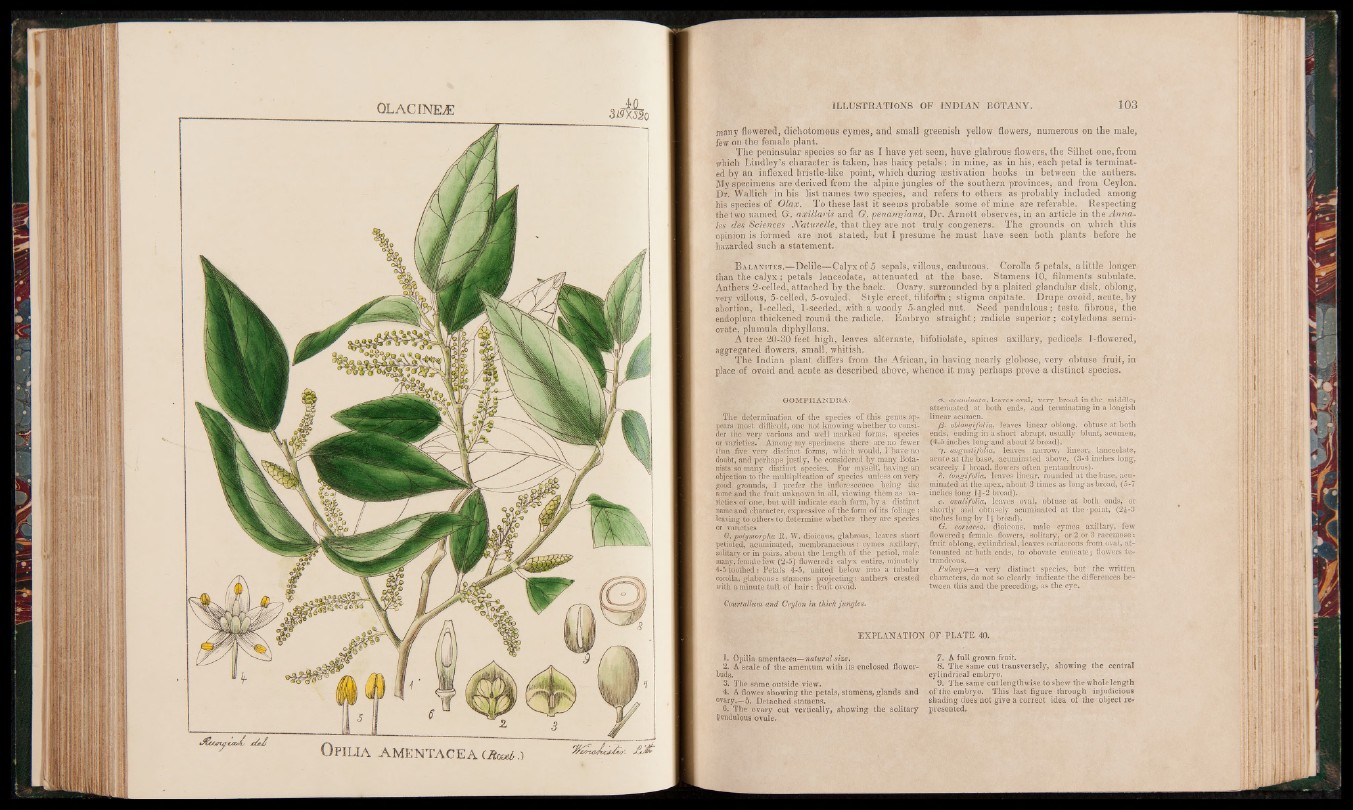
ILLUSTRATIONS OF INDIAN BOTANY. 103
iff
many flowered, dichotomous cymes, and small greenish yellow flowers, numerous on the male,
few on the female plant.
The peninsular species so far as I have yet seen, have glabrous flowers, the Silhet one, from
which Lindley’s character is taken, has hairy petals : in mine, as in his, each petal is terminated
by an inflexed bristle-like point, which during aestivation hooks in between the anthers.
My specimens are derived from the alpine jungles of the southern provinces, and from Ceylon.
Dr. Wallich in his list names two species, and refers to others as probably included among
his species of Olax. To these last it seems probable some of mine are referable. Respecting
the two named G. axillaris and G, 'pentinQiaria, Dr. Arnott observes, in an article in the Anna-
les des Sciences JYaturelle, that they are not truly congeners. The grounds on which this
opinion is formed are not stated, but I presume he must have seen both plants before he
hazarded such a statement.
B alanites.—Delile—Calyx of 5 sepals, villous, caducous. Corolla 5 petals, a little longer
than the calyx; petals lanceolate, attenuated at the base. Stamens 10, filaments subulate.
Anthers 2-celled, attached by the back. Ovary, surrounded by a plaited glandular disk, oblong,
very villous, 5-celled, 5-ovuled. Style erect, filifortn ; stigma capitate. Drupe ovoid, acute, by
abortion, 1-celled, 1-seeded, with a woody 5-angled nut. Seed pendulous; testa fibrous, the,
endoplura thickened round the radicle.- Embryo straight; radicle superior; cotyledons semi-
ovate, plumula diphyllous.
A tree 20-30 feet high, leaves alternate, bifoliolate, spines axillary, pedicels 1-flowered,
aggregated flowers, small, whitish.
The Indian plant differs from the African, in having nearly globose, very obtuse fruit, in
place of ovoid and acute as described above, whence it may perhaps prove a distinct species.
GOMPHANDRA.
The determination of the species of this genus appears
most difficult, one not knowing whether to consider
the very various and well marked forms, species
or varieties. Among my specimens there are no fewer
than five very distinct forms, which would, I have no
doubt, and perhaps justly, be considered by many Botanists
so many distinct species. For myself, having an
objection to the multiplication of species unless on very
good grounds, I prefer the inflorescence being the
same and the fruit unknown in all, viewing them as varieties
of one, but will indicate each form, by a distinct
name and character, expressive of the form of its foliage;
leaving to others to determine whether they are species
or varieties
G. pohjmorpha R. W. dioicous, glabrous, leaves short
petioled, acuminated, membranacious: cymes axillary,
solitary or in pairs, about the length of the petiol, male
many, female few (2-5) flowered: calyx entire, minutely
4-5 toothed: Petals 4-5, united below into a tubular
corolla, glabrous: stamens projecting; anthers crested
with a minute tuft of hair : fruit ovoid.
Courtattum'and Ceylon in thick jungles.
a. • acuminata, leaves oval, very broad in the middle,
attenuated at both ends, and terminating in a longisli
linear acumen.
y3. oblongifolia, leaves linear oblong, obtuse at both
ends, ending in a short abrupt, usually blunt, acumen,
(4-5 inches long and about 2 broad).
7 . angustifolia, leaves narrow, linear, lanceolate,
acute at the base, (acuminated above, (3-4 inches long,
scarcely 1 broad, flowers often pentandrous).
8. longi folia, leaves linear, rounded at the base, acuminated
at the apex, about 3 times as long as broad, (5-7
inches long 1 J-2 broad).
e. ovalifolia, leaves oval, obtuse, at both ends,' or
shortly and obtusely acuminated at the -point, (2|-3
inches long by 1 J broad).
G. coriacea, dioicous, male cymes axillary, few
flowered; female flowers, solitary, or 2 or 3 racemose:
fruit oblong, cylindrical, leaves coriaceous from oval, attenuated
at both ends, to obovate cuneate; flowers te-
. trandrousl
Pulneys—a very distinct species, but the written
characters, do not so clearly indicate the differences between
this and the preceding, as the eye.
EXPLANATION OF-PLATE 40.
1. Opilia amentacea—natural size.
2. A scale of the amentum with its enclosed flower-
buds.
3. The same outside view.
4. A flower showing the petals, stamens, glands and
ovary.—5. Detached stamens.
6. The ovary cut vertically, showing the solitary
Pendulous ovule.
7. A full grown fruit.
8. The same cut transversely, showing the central
cylindrical embryo.
9. The same cut lengthwise to shew the whole length
of the embryo. This last figure through injudicious
shading does not give a correct idea of the object represented.